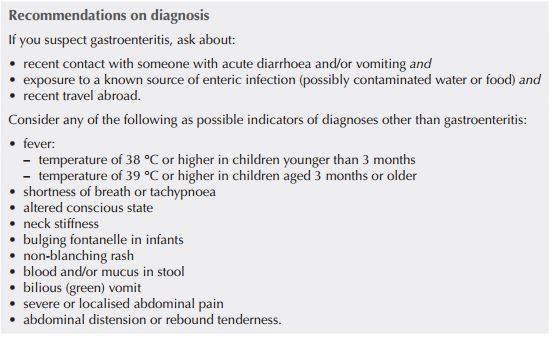The complete 2009 Diarrhoea and Vomitting Caused by Gastroenteritis: Diagnosis, Assessment and Management in Children Under 5 Years (pdf) (html version) from the British National Health commissioned by the (British) National Institute for Health and Clinical Excellence (NICE), is an outstanding reference.
There is a parents version of the NICE guideline Understanding NICE guidance: Diarrhoea and vomiting in children.
What follows are the “Key Recommendations” from the Guidelines:
What follows below are further points from the Guidelines:
More on Hypernatremic Dehydration from Spotting the Sick Child*:
“There is a special kind of dehydration which happens in babies, which is serious and can be difficult to spot. Babies have immature kidneys, and if they are dehydrated through not feeding or through diarrhoea, the kidneys are not able to compensate by retaining water in the right proportions. There is then an imbalance between sodium and water, which results in a high blood sodium concentration. This is called hypernatraemic dehydration. The sodium level may be very high, such as 160.
“It is most commonly seen in the first couple of weeks of life when breastfeeding has been difficult to establish. It can also be seen in bottle fed babies if the feeds have been made up incorrectly, or in babies with profuse watery diarrhoea.
“The high sodium levels in the blood cause the baby to be drowsy and not wake up to feed. This makes the situation worse. From the point of view of diagnosis, the high sodium levels prevent the skin and fontanelle and eyes from appearing dehydrated, so it is very easy to miss the diagnosis.
“It may well present as a baby with difficulty in feeding. On closer questioning the baby will probably have become drowsy, and this causes a vicious circle of poor feeding and worsening dehydration. This is why it is important to examine the baby physiologically – you will notice the fast heart and respiratory rate. Also if you are aware of this condition, you will think of it.
“If you think hypernatraemic dehydration is a possible diagnosis the infant will need urgent paediatric referral for an immediate blood test and treatment.”
*Spotting the Sick Child, www.spottingthesickchild, is an outstanding relatively brief online course on pediatric acute care available free following registration. One of its (many) strengths is the large number of videos showing acutely ill infants and children.

















